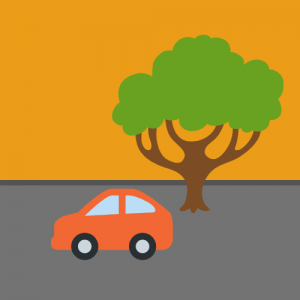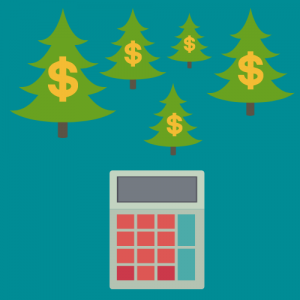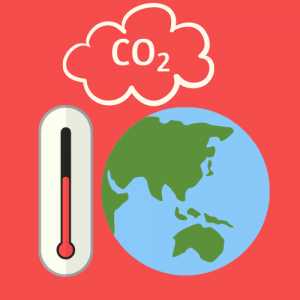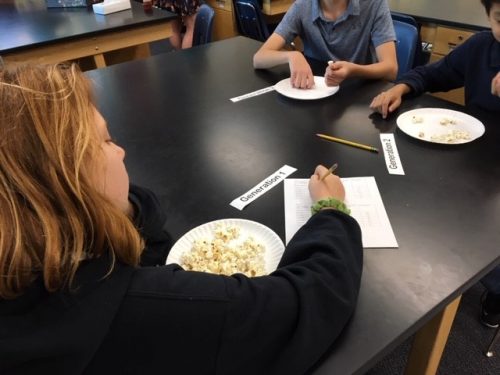As a 7th grade Environmental Science teacher, I often turn to Project Learning Tree (PLT) for ideas and inspiration. So when Virginia adopted new environmental science content and guidelines earlier this year, I took a deep breath and opened my trustworthy PreK-8 Environmental Education Activity Guide for inspiration. Unsurprisingly, just as it guided me (pun intended!) through previous curriculum and standards changes in years past, I found more than 15 engaging activities to strongly correlate with the new state guidelines.
I used these activities throughout the 2018-2019 school year with my middle school students and they absolutely loved them! Here are my top PLT activities to teach essential environmental science concepts to 7th – 9th graders:
PLT PreK-8 Guide – Activity 14—Renewable or Not 
Concept: Resources – Students explore conservation efforts to better appreciate Earth’s resources.
I used this activity at the beginning of the school year to introduce examples of different natural resources. Students participated in hands-on lessons and simulated resource scarcity with popcorn and candy to discover what defines renewable and non-renewable natural resources.
In one of the activity’s simulations, students randomly selected slips of paper that determined if they were part of the “1st Generation,” “2nd Generation,” or “3rd Generation” of resource consumers. The students lucky enough to draw 1st Generation slips got to come up first and take as much popcorn out of a big bowl as they wanted. The popcorn represented a finite supply of a non-renewable natural resource.
When my class tried it out, one of my 1st Generation students took almost all the popcorn. The reaction of the remaining students was priceless, as it clearly demonstrated how unfair it is for a generation to use resources without regard to future generations. We repeated the simulations several times so that students could experiment with different ways to sustainably use renewable and nonrenewable resources.
Here is the worksheet that I developed for students to complete as they did this activity.

PLT PreK-8 Guide – Activity 56—We Can Work It Out
(AKA Ms. Keesha Thomas and the Heritage Oak Dilemma)
Concept: Human impact and civic responsibility – Students investigate environmental policies to understand their civic responsibility.
This activity was so memorable to my students that they referred to “Ms. Keesha Thomas” throughout the school year as we delved deeper into environmental issues. In this simulation, students took on the role of different stakeholders in a land-use conflict. The conflict pits Ms. Keesha Thomas (who wants to cut down her town’s Heritage Oak tree to create a lot for a luxury car sales business), against other local stakeholders (her neighbors, the City’s Planning Group, and an environmental organization).
The various stakeholders have different ideas about how the land should be used. Because many of my students were reluctant to take on the role of Ms. Thomas, I modified the instructions to make the activity more competitive by having students role-play partners at law firms representing each of the stakeholders. Students got really creative – they named their law firms, practiced their arguments, and came to class dressed in interesting outfits as they presented before the “city council.”
This simulation helped my students learn how complicated land-use issues are – while also illustrating how important it is to understand diverse points-of-view. They learned about compromise and the many different ways that communities make decisions. To build on the concepts taught through this activity, I then used PLT’s PreK-8 Guide Activities 57—Democracy in Action and Activity 58—There Ought To Be A Law.
Later in the year, my class examined more complex environmental issues with PLT’s secondary module Focus on Forests. In Activity 4—Tough Choices, students discovered how to analyze real-world issues by examining the stakeholders and their values and opinions. They also learned the importance of determining facts and looking at all sides of an issue. Students then brainstormed possible solutions to the issues and learned the value of compromise.
Here’s a PowerPoint I created to go with this activity that worked great!
 PLT Teaching with i-Tree
PLT Teaching with i-Tree
Concept: Ecosystem Services – Students investigate and understand the many and varied benefits that humans obtain from our natural environment.
The three engaging activities in this free online unit provided an excellent way for my students to grasp the meaning of “Ecosystem Services.” They were immediately immersed in measuring the trees on our school grounds, inputting the data into a free online Forest Service calculator, and determining the exact dollar value of the trees’ environmental benefits. Students discovered that the trees on the school grounds provided more than $1,000 worth of annual benefits, by mitigating greenhouse gases, improving air quality, intercepting stormwater, and lowering the school’s energy use.
Many students told me that they used the i-Tree calculator to analyze the value of trees around their own homes, and some collaborated with their local Scout group or Boys & Girls Club to assess the value of trees in their broader community.

PLT E-Unit: Carbon & Climate and PreK-8 Guide – Activity 84—The Global Climate
Concept: Global Climate Change – Students learn more about the carbon cycle and greenhouse effect to better understand global climate change.
The fact-based investigations in these activities helped my students learn the critical concepts needed to understand climate science. By analyzing scientific data, the activities encouraged students to come to their own conclusions about our global climate – one more example of PLT’s much-appreciated commitment to teaching kids “how to think, not what to think.”
For example, in Activity 84—The Global Climate, students graphed the concentration of carbon dioxide (CO2) in the atmosphere from 1958 to 2016 with data taken from Hawaii’s Mauna Loa Observatory. They looked for patterns and trends over time and we discussed major events in history that may account for the world’s increase in CO2 (such as the Industrial Revolution.) I then took this activity one step further, and directed students to go to NASA’s Global Climate Change website, so that students could compare changes in CO2 over time with changes in global temperature and Arctic Sea ice. Looking at the data in time-lapse, students can infer relationships.
Both the stations in the E-Unit and the lessons in Activity 84 kept students actively engaged as they researched the carbon cycle and role of carbon in maintaining climate. They learned about past changes in our climate, and were individually inspired to know more about what they can personally do about climate change.
I hope these PLT activities help you teach essential environmental science concepts to your students.

Please share how you are using PLT in your classroom!
Visit the links below to learn more about PLT’s curriculum.
PLT PreK-8 Environmental Education Activity Guide: https://www.plt.org/curriculum/environmental-education-activity-guide/
PLT Teaching with i-Tree: https://www.plt.org/curriculum/teaching-with-itree/
PLT Carbon & Climate E-Unit: https://www.plt.org/carbon-climate-unit
PLT Focus on Forests: https://www.plt.org/curriculum/focus-on-forests/




